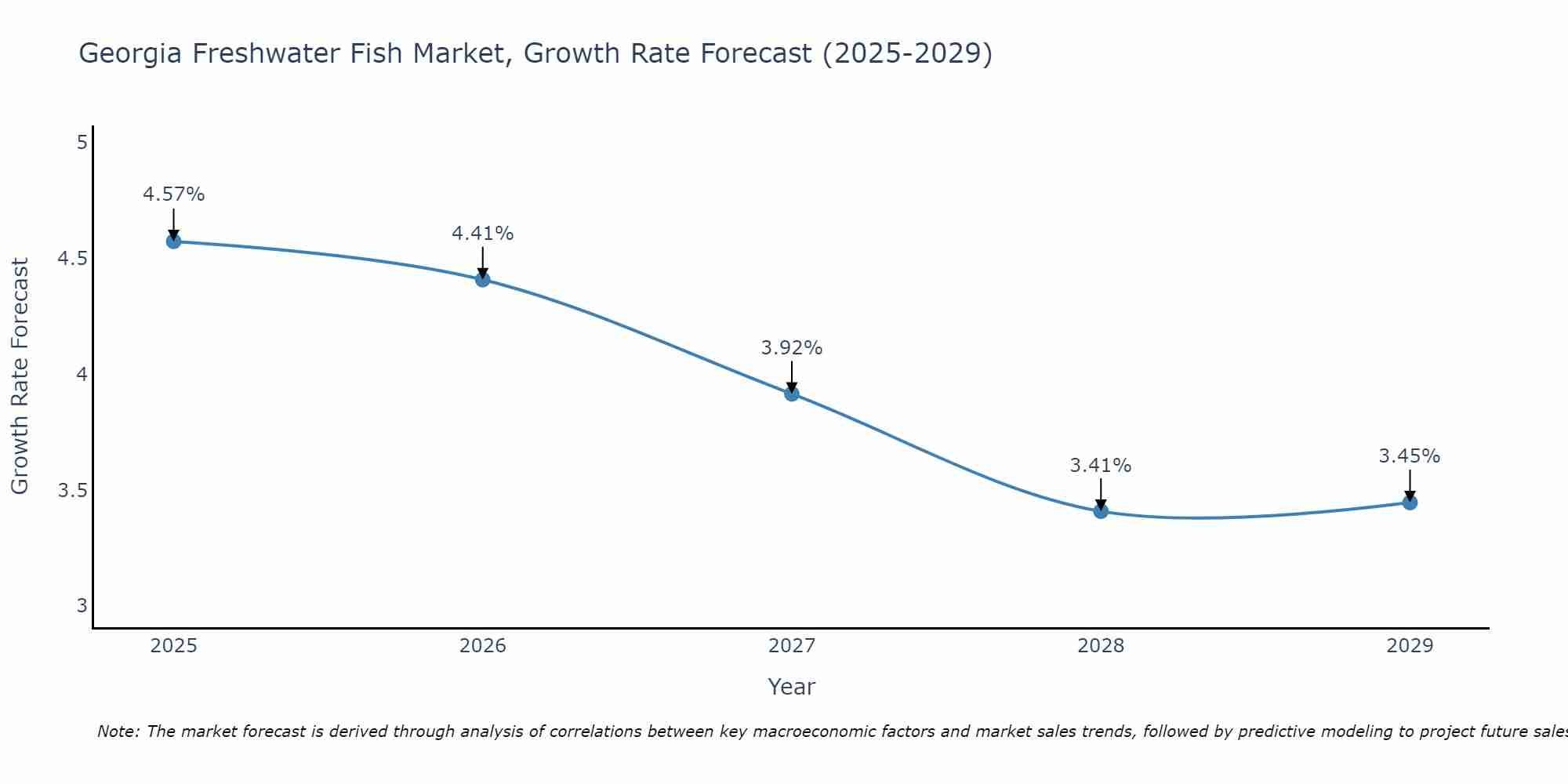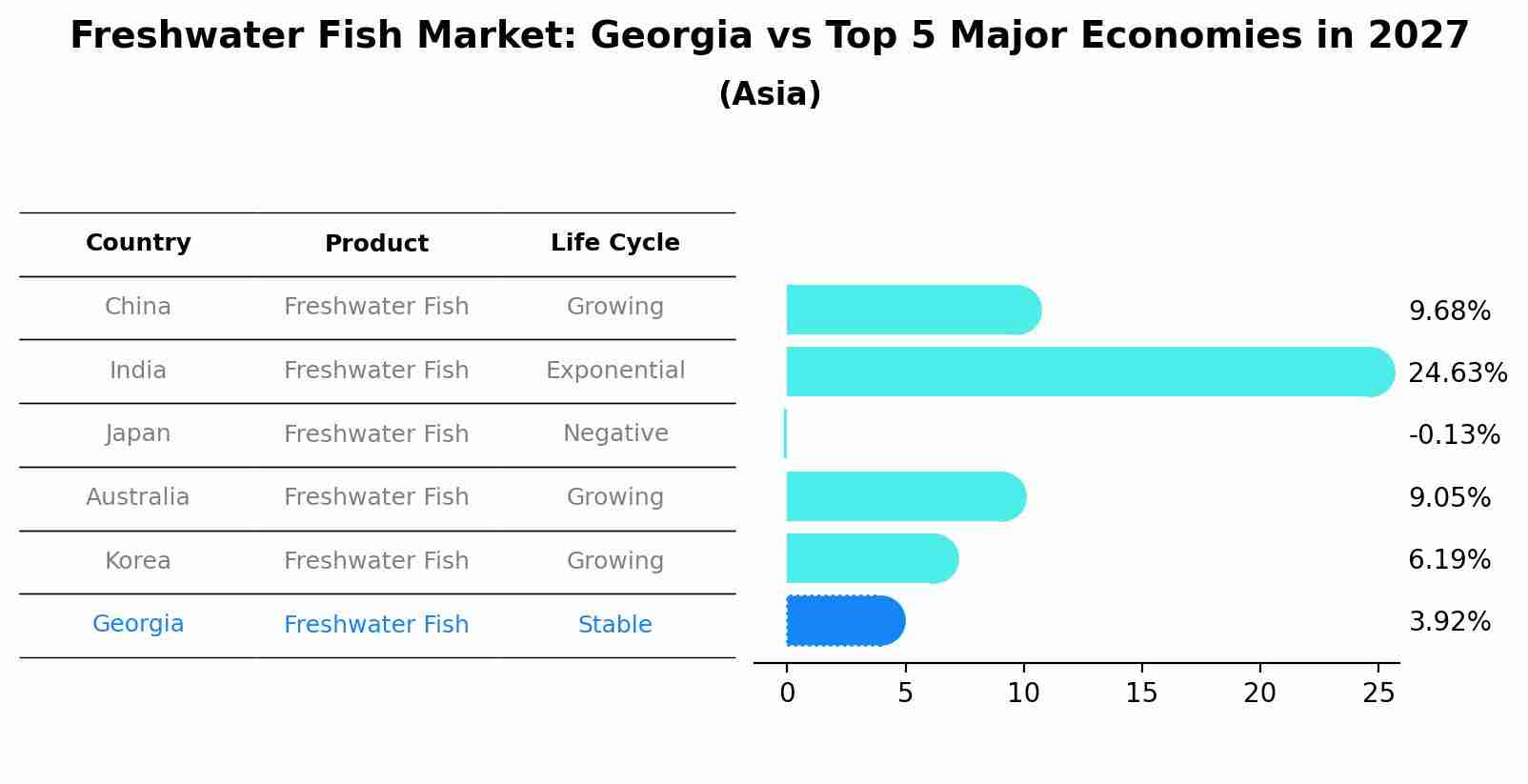Georgia Freshwater Fish Market (2025-2031) Outlook | Share, Size, Industry, Forecast, Companies, Trends, Revenue, Value, Analysis & Growth
| Product Code: ETC386520 | Publication Date: Aug 2022 | Updated Date: Jul 2025 | Product Type: Market Research Report | |
| Publisher: 6Wresearch | Author: Dhaval Chaurasia | No. of Pages: 75 | No. of Figures: 35 | No. of Tables: 20 |
Georgia Freshwater Fish Market Size Growth Rate
The Georgia Freshwater Fish Market is projected to witness mixed growth rate patterns during 2025 to 2029. Starting high at 4.57% in 2025, the market steadily declines to 3.45% by 2029.

Freshwater Fish Market: Georgia vs Top 5 Major Economies in 2027 (Asia)
The Freshwater Fish market in Georgia is projected to grow at a stable growth rate of 3.92% by 2027, within the Asia region led by China, along with other countries like India, Japan, Australia and South Korea, collectively shaping a dynamic and evolving market environment driven by innovation and increasing adoption of emerging technologies.

Georgia Freshwater Fish Market Synopsis
The Georgia freshwater fish market is characterized by a diverse range of species, including catfish, bass, crappie, and trout, sourced from local rivers, lakes, and aquaculture farms. Catfish, particularly channel catfish, is a popular choice among consumers due to its mild flavor and versatile cooking options. Bass, such as largemouth and spotted bass, are sought after by anglers for sport fishing, while crappie and trout appeal to those looking for a delicate and sweet-tasting fish. The market is influenced by seasonal variations in fish availability, with peak fishing seasons for different species driving fluctuations in supply and demand. Local markets, restaurants, and fishmongers play a key role in connecting consumers with these freshwater delicacies, reflecting Georgia`s rich culinary tradition and vibrant fishing culture.
Georgia Freshwater Fish Market Trends
The Georgia Freshwater Fish Market is currently experiencing a trend towards sustainable and locally sourced products. Consumers are increasingly seeking out fish that are caught or raised in Georgia as opposed to imported varieties. This aligns with the growing interest in supporting local businesses and reducing the carbon footprint associated with transporting seafood long distances. Additionally, there is a rising demand for freshwater fish species that are considered to be healthier and more environmentally friendly choices, such as catfish and trout. As a result, fish farms in Georgia are expanding their production of these popular species to meet the market demand. Overall, the trend towards sustainability, local sourcing, and health-conscious choices is shaping the Georgia Freshwater Fish Market`s landscape.
Georgia Freshwater Fish Market Challenges
One of the main challenges faced in the Georgia Freshwater Fish Market is competition from imported fish species. These imported species often have lower production costs and are priced more competitively than locally sourced freshwater fish. This creates a challenge for Georgia freshwater fish producers to effectively compete in the market. Additionally, environmental factors such as water quality and availability can impact the overall health and growth of freshwater fish species, leading to fluctuations in supply and quality. Furthermore, consumer preferences and awareness play a significant role, as there may be a lack of understanding or demand for locally sourced freshwater fish products compared to more popular or familiar options. Overall, addressing these challenges requires a strategic approach to marketing, sustainability practices, and education to promote the value and benefits of Georgia freshwater fish in the market.
Georgia Freshwater Fish Market Investment Opportunities
Investment opportunities in the Georgia Freshwater Fish Market include aquaculture farms, fish processing facilities, and distribution networks. With the growing demand for locally sourced, sustainable seafood, there is a potential for high returns on investment in this market. Investors can consider funding new aquaculture projects to breed popular freshwater fish species such as catfish, trout, and bass. Additionally, investing in modern processing facilities equipped with state-of-the-art technology can enhance efficiency and quality control. Developing a strong distribution network to supply fresh fish to restaurants, grocery stores, and seafood markets across Georgia can also be a lucrative investment opportunity in this market. Overall, the Georgia Freshwater Fish Market presents diverse investment prospects for those looking to capitalize on the increasing demand for high-quality, locally produced seafood.
Jordan Agar Market Government Policies
Government policies related to the Georgia Freshwater Fish Market focus on conservation efforts to protect native fish species, regulate fishing practices to ensure sustainability, and manage freshwater ecosystems. The Georgia Department of Natural Resources implements regulations such as size limits, bag limits, and seasonal restrictions to maintain healthy fish populations and prevent overfishing. Additionally, water quality standards and habitat restoration initiatives are in place to safeguard the natural environment that supports freshwater fish species. The government also works closely with stakeholders, including fishermen, conservation organizations, and researchers, to monitor the market trends, address potential threats to fish populations, and promote responsible fishing practices. Overall, the policies aim to balance economic opportunities in the freshwater fish market with environmental conservation to ensure long-term viability and sustainability.
Georgia Freshwater Fish Market Future Outlook
The Georgia freshwater fish market is poised for steady growth in the coming years due to increasing consumer interest in locally sourced, sustainable food options. With a rich diversity of freshwater fish species in Georgia`s rivers and lakes, there is a growing opportunity for aquaculture and wild-caught fish operations to meet the demand for fresh, high-quality fish products. Additionally, the trend towards healthier eating habits and the popularity of seafood in general are expected to drive further growth in the market. To capitalize on these opportunities, market participants should focus on promoting the unique characteristics of Georgia freshwater fish, implementing sustainable fishing practices, and expanding distribution channels to reach a wider consumer base. Overall, the future outlook for the Georgia freshwater fish market is positive, with potential for continued expansion and profitability.
Key Highlights of the Report:
- Georgia Freshwater Fish Market Outlook
- Market Size of Georgia Freshwater Fish Market, 2024
- Forecast of Georgia Freshwater Fish Market, 2031
- Historical Data and Forecast of Georgia Freshwater Fish Revenues & Volume for the Period 2021 - 2031
- Georgia Freshwater Fish Market Trend Evolution
- Georgia Freshwater Fish Market Drivers and Challenges
- Georgia Freshwater Fish Price Trends
- Georgia Freshwater Fish Porter's Five Forces
- Georgia Freshwater Fish Industry Life Cycle
- Historical Data and Forecast of Georgia Freshwater Fish Market Revenues & Volume By Water temperature for the Period 2021 - 2031
- Historical Data and Forecast of Georgia Freshwater Fish Market Revenues & Volume By Warmwater for the Period 2021 - 2031
- Historical Data and Forecast of Georgia Freshwater Fish Market Revenues & Volume By Coldwater for the Period 2021 - 2031
- Historical Data and Forecast of Georgia Freshwater Fish Market Revenues & Volume By Type for the Period 2021 - 2031
- Historical Data and Forecast of Georgia Freshwater Fish Market Revenues & Volume By Carp for the Period 2021 - 2031
- Historical Data and Forecast of Georgia Freshwater Fish Market Revenues & Volume By Barbel for the Period 2021 - 2031
- Historical Data and Forecast of Georgia Freshwater Fish Market Revenues & Volume By Cyprinid for the Period 2021 - 2031
- Historical Data and Forecast of Georgia Freshwater Fish Market Revenues & Volume By Tilapia for the Period 2021 - 2031
- Historical Data and Forecast of Georgia Freshwater Fish Market Revenues & Volume By Other Freshwater Fish for the Period 2021 - 2031
- Historical Data and Forecast of Georgia Freshwater Fish Market Revenues & Volume By Distribution for the Period 2021 - 2031
- Historical Data and Forecast of Georgia Freshwater Fish Market Revenues & Volume By Supermarkets & Hypermarkets for the Period 2021 - 2031
- Historical Data and Forecast of Georgia Freshwater Fish Market Revenues & Volume By Convenience Stores for the Period 2021 - 2031
- Historical Data and Forecast of Georgia Freshwater Fish Market Revenues & Volume By Online Retail for the Period 2021 - 2031
- Historical Data and Forecast of Georgia Freshwater Fish Market Revenues & Volume By Others for the Period 2021 - 2031
- Georgia Freshwater Fish Import Export Trade Statistics
- Market Opportunity Assessment By Water temperature
- Market Opportunity Assessment By Type
- Market Opportunity Assessment By Distribution
- Georgia Freshwater Fish Top Companies Market Share
- Georgia Freshwater Fish Competitive Benchmarking By Technical and Operational Parameters
- Georgia Freshwater Fish Company Profiles
- Georgia Freshwater Fish Key Strategic Recommendations
Frequently Asked Questions About the Market Study (FAQs):
- Single User License$ 1,995
- Department License$ 2,400
- Site License$ 3,120
- Global License$ 3,795
Search
Related Reports
- Portugal Electronic Document Management Market (2025-2031) | Strategy, Consumer Insights, Analysis, Investment Trends, Opportunities, Growth, Size, Share, Industry, Revenue, Segments, Value, Segmentation, Supply, Forecast, Restraints, Outlook, Competition, Drivers, Trends, Demand, Pricing Analysis, Competitive, Strategic Insights, Companies, Challenges
- France Electronic Document Management Market (2025-2031) | Strategy, Consumer Insights, Analysis, Investment Trends, Opportunities, Growth, Size, Share, Industry, Revenue, Segments, Value, Segmentation, Supply, Forecast, Restraints, Outlook, Competition, Drivers, Trends, Demand, Pricing Analysis, Competitive, Strategic Insights, Companies, Challenges
- Portugal Occupational Health & Safety Services Market (2025-2031) | Strategy, Consumer Insights, Analysis, Investment Trends, Opportunities, Growth, Size, Share, Industry, Revenue, Segments, Value, Segmentation, Supply, Forecast, Restraints, Outlook, Competition, Drivers, Trends, Demand, Pricing Analysis, Competitive, Strategic Insights, Companies, Challenges
- Netherlands Occupational Health and Safety Services Market (2025-2031) | Strategy, Consumer Insights, Analysis, Investment Trends, Opportunities, Growth, Size, Share, Industry, Revenue, Segments, Value, Segmentation, Supply, Forecast, Restraints, Outlook, Competition, Drivers, Trends, Demand, Pricing Analysis, Competitive, Strategic Insights, Companies, Challenges
- Belgium and Luxembourg Facility Management Market (2025-2031) | Strategy, Consumer Insights, Analysis, Investment Trends, Opportunities, Growth, Size, Share, Industry, Revenue, Segments, Value, Segmentation, Supply, Forecast, Restraints, Outlook, Competition, Drivers, Trends, Demand, Pricing Analysis, Competitive, Strategic Insights, Companies, Challenges
- Russia Women Intimate Apparel Market (2025-2031) | Strategy, Consumer Insights, Analysis, Investment Trends, Opportunities, Growth, Size, Share, Industry, Revenue, Segments, Value, Segmentation, Supply, Forecast, Restraints, Outlook, Competition, Drivers, Trends, Demand, Pricing Analysis, Competitive, Strategic Insights, Companies, Challenges
- Africa Chocolate Market (2025-2031) | Size, Share, Trends, Growth, Revenue, Analysis, Forecast, industry & Outlook
- Global Hydroxychloroquine And Chloroquine Market (2025-2031) | Industry, Trends, Size, Outlook, Growth, Value, Companies, Revenue, Analysis, Share, Forecast
- Saudi Arabia Plant Maintenance Market (2025-2031) | Industry, Size, Growth, Revenue, Value, Companies, Forecast, Analysis, Share & Trends
- Taiwan Electric Truck Market (2025-2031) | Outlook, Industry, Revenue, Size, Forecast, Growth, Analysis, Share, Companies, Value & Trends
Industry Events and Analyst Meet
Our Clients
Whitepaper
- Middle East & Africa Commercial Security Market Click here to view more.
- Middle East & Africa Fire Safety Systems & Equipment Market Click here to view more.
- GCC Drone Market Click here to view more.
- Middle East Lighting Fixture Market Click here to view more.
- GCC Physical & Perimeter Security Market Click here to view more.
6WResearch In News
- Doha a strategic location for EV manufacturing hub: IPA Qatar
- Demand for luxury TVs surging in the GCC, says Samsung
- Empowering Growth: The Thriving Journey of Bangladesh’s Cable Industry
- Demand for luxury TVs surging in the GCC, says Samsung
- Video call with a traditional healer? Once unthinkable, it’s now common in South Africa
- Intelligent Buildings To Smooth GCC’s Path To Net Zero













